 | |
| Names | |
|---|---|
| Preferred IUPAC name
Propan-2-amine | |
Other names
| |
| Identifiers | |
3D model (JSmol) |
|
| 3DMet | |
| 605259 | |
| ChEBI | |
| ChEMBL | |
| ChemSpider | |
| ECHA InfoCard | 100.000.783 |
| EC Number |
|
| KEGG | |
| MeSH | 2-propylamine |
PubChem CID |
|
| RTECS number |
|
| UNII | |
| UN number | 1221 |
CompTox Dashboard (EPA) |
|
| |
| |
| Properties | |
| C3H9N | |
| Molar mass | 59.112 g·mol−1 |
| Appearance | Colourless liquid |
| Odor | "Fishy"; ammoniacal |
| Density | 688 mg mL−1 |
| Melting point | −95.20 °C; −139.36 °F; 177.95 K |
| Boiling point | 31 to 35 °C; 88 to 95 °F; 304 to 308 K |
| Miscible | |
| log P | 0.391 |
| Vapor pressure | 63.41 kPa (at 20 °C) |
Refractive index (nD) |
1.3742 |
| Thermochemistry | |
Heat capacity (C) |
163.85 J K−1 mol−1 |
Std molar entropy (S⦵298) |
218.32 J K−1 mol−1 |
Std enthalpy of formation (ΔfH⦵298) |
−113.0–−111.6 kJ mol−1 |
Std enthalpy of combustion (ΔcH⦵298) |
−2.3540–−2.3550 MJ mol−1 |
| Hazards | |
| GHS labelling: | |
  | |
| Danger | |
| H224, H315, H319, H335 | |
| P210, P261, P305+P351+P338 | |
| Flash point | −18 °C (0 °F; 255 K) |
| 402 °C (756 °F; 675 K) | |
| Explosive limits | 2–10.4% |
| Lethal dose or concentration (LD, LC): | |
LD50 (median dose) |
|
LC50 (median concentration) |
4,000 ppm (rat, 4 hr)[1] |
LCLo (lowest published) |
7000 ppm (mouse, 40 min)[1] |
| NIOSH (US health exposure limits): | |
PEL (Permissible) |
TWA 5 ppm (12 mg/m3)[2] |
REL (Recommended) |
None established[2] |
IDLH (Immediate danger) |
750 ppm[2] |
| Related compounds | |
Related alkanamines |
|
Related compounds |
2-Methyl-2-nitrosopropane |
Except where otherwise noted, data are given for materials in their standard state (at 25 °C [77 °F], 100 kPa).
Infobox references | |
Isopropylamine (monoisopropyl amine, MIPA, 2-Propylamine) is an organic compound, an amine. It is a hygroscopic colorless liquid with ammonia-like odor. It is miscible with water and flammable. It is a valuable intermediate in chemical industry.[3]
Reactions
Isopropylamine exhibits reactions typical of other simple alkyl amines, i.e. protonation, alkylation, acylation, condensation with carbonyls. Like other simple aliphatic amines, isopropylamine is a weak base: the pKa of [(CH3)2)CHNH3]+ is 10.63.[4]
Preparation and use
Isopropylamine can be obtained by reaction of isopropyl alcohol with ammonia in presence of a catalyst:[3]
- (CH3)2CHOH + NH3 → (CH3)2CHNH2 + H2O
Isopropylamine is a building block for the preparation of many herbicides and pesticides including atrazine, bentazon, glyphosate, imazapyr, ametryne, desmetryn, prometryn, pramitol, dipropetryn, propazine, fenamiphos, and iprodione.[3] It is a regulating agent for plastics, intermediate in organic synthesis of coating materials, plastics, pesticides, rubber chemicals, pharmaceuticals and others, and as an additive in the petroleum industry.
References
- 1 2 "Isopropylamine". Immediately Dangerous to Life and Health. National Institute for Occupational Safety and Health. 4 December 2014. Retrieved 14 April 2015.
- 1 2 3 NIOSH Pocket Guide to Chemical Hazards. "#0360". National Institute for Occupational Safety and Health (NIOSH).
- 1 2 3 Karsten Eller, Erhard Henkes, Roland Rossbacher, Hartmut Höke "Amines, Aliphatic" in Ullmann's Encyclopedia of Industrial Chemistry, Wiley-VCH, Weinheim, 2005. doi:10.1002/14356007.a02_001
- ↑ H. K. Hall, Jr. (1957). "Correlation of the Base Strengths of Amines". J. Am. Chem. Soc. 79 (20): 5441–5444. doi:10.1021/ja01577a030.
External links
- International Chemical Safety Card 0908
- NIOSH Pocket Guide to Chemical Hazards. "#0360". National Institute for Occupational Safety and Health (NIOSH).